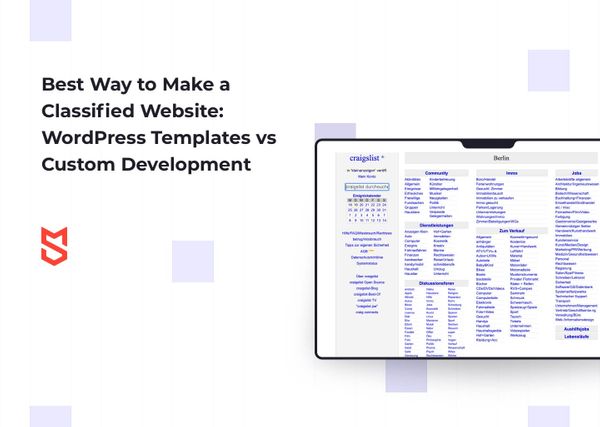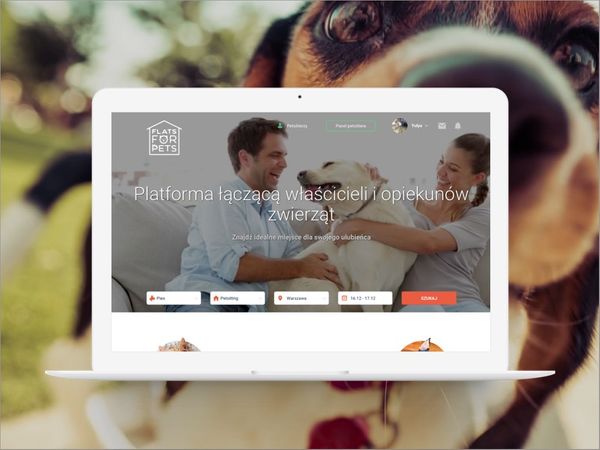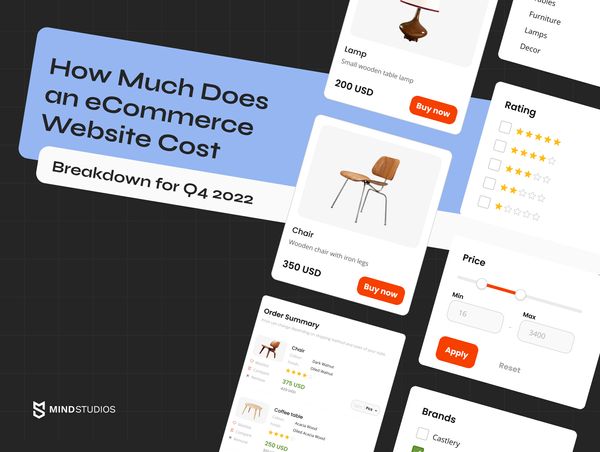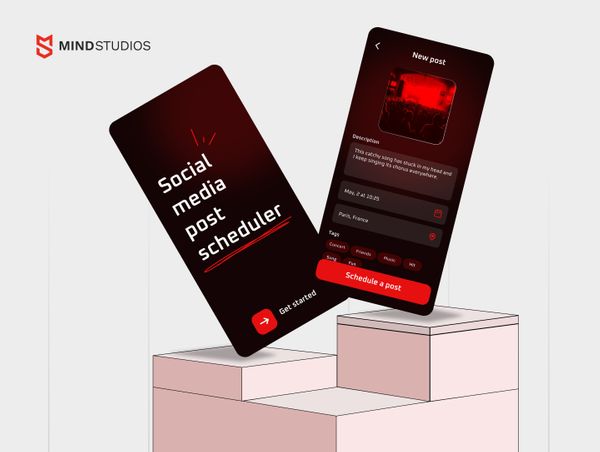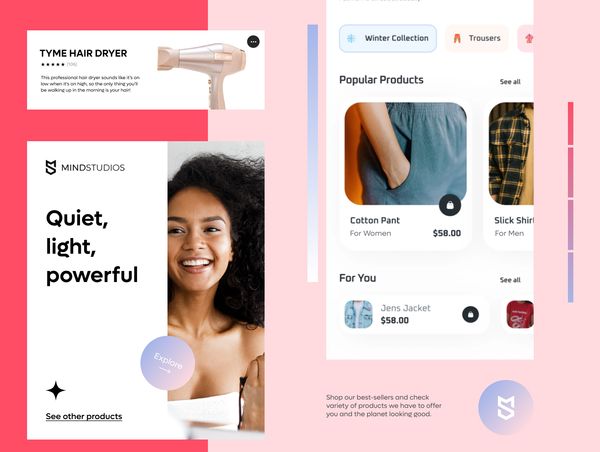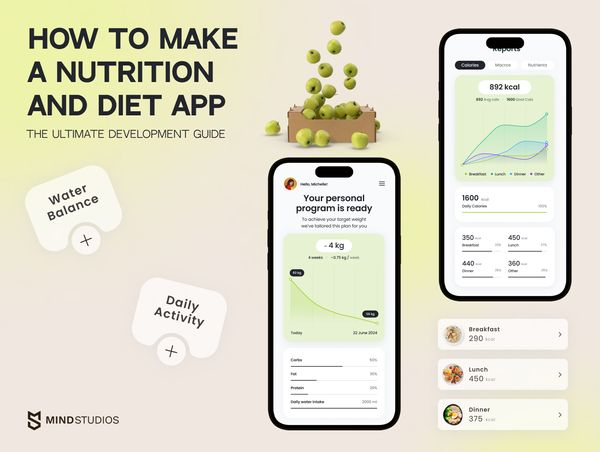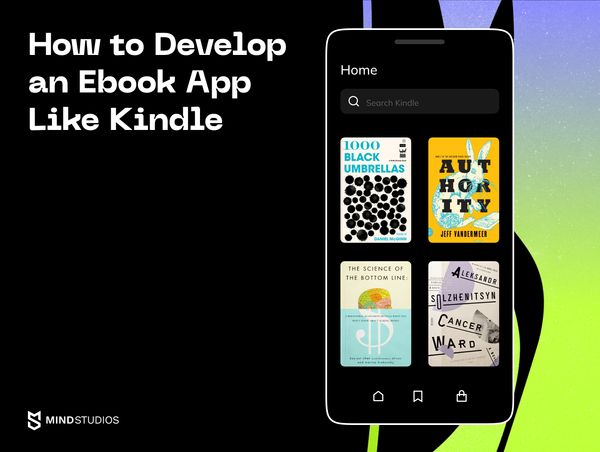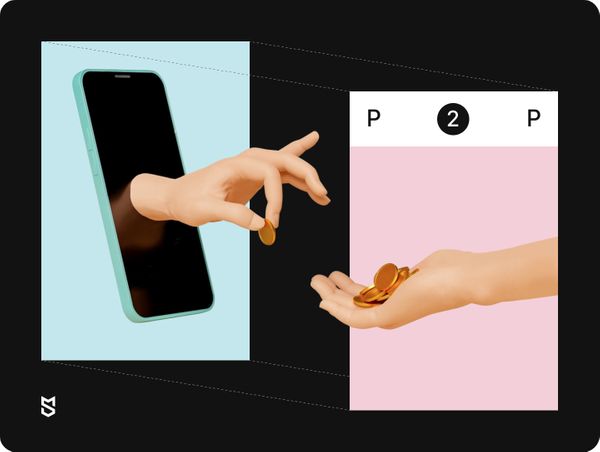
What is a peer-to-peer marketplace, how is it different from other eCommerce websites, how to build a peer-to-peer website — you’ll find answers to these and related questions in this article.
In our years of working in software development, we’ve dabbled in multiple niches, and eCommerce is one of them. In this article, we draw on our knowledge to provide some useful insights for those with a peer-to-peer marketplace development idea.
And if you have any questions left after reading, don’t hesitate to contact us.
What is a peer-to-peer marketplace?
Peer-to-peer (P2P) marketplaces are one of the business models under the eCommerce umbrella. P2P marketplaces provide a platform for individual sellers and buyers to find each other and trade goods and services.
In this article, we’d like to dive into the peer-to-peer business model and offer tips on building P2P marketplace software from scratch.
Why build a peer-to-peer marketplace platform?
Before learning how to build a P2P platform, let's find out what the reasons for the development may be. Statistics show that the popularity of buying things online has been steadily increasing. In 2021, it was estimated that the number of people making purchases online would reach 2.14 billion. Ecommerce is growing, and it won’t stop in the near future.
Peer-to-peer marketplaces are exceptionally popular for their high convenience to both buyers and sellers, and this popularity will only grow in the future as the world becomes more and more globalized.
For sellers, a P2P website is useful because it:
- provides space for selling their products or services without investing in a website of their own
- provides additional visibility with little to no effort
- makes it easier for buyers to find the seller (especially true for niche marketplaces)
- manages payments
- offers global reach, meaning increase in customers manyfold
For buyers, a P2P marketplace has the following important advantages:
- a selection of sellers to compare and choose the most suitable
- straightforward payments
- access to sellers from all over the world
Finally, the most winning participant of the whole P2P business model is the platform owner. If you build your own P2P eCommerce marketplace, you don’t need to set up production of any items or services yourself, like a traditional online store owner would need to. You also won’t need to deal with storage, order packing, or shipping — with P2P marketplaces, sellers do all this on their own.
Finally, it matters not where the owner of the P2P marketplace resides, physically, or where sellers and buyers are. A P2P marketplace as a business model is an ultimate child of globalization.
Basically, a marketplace owner reaps the benefits of a business without the connected struggles of producing anything.
What makes a P2P marketplace unique?
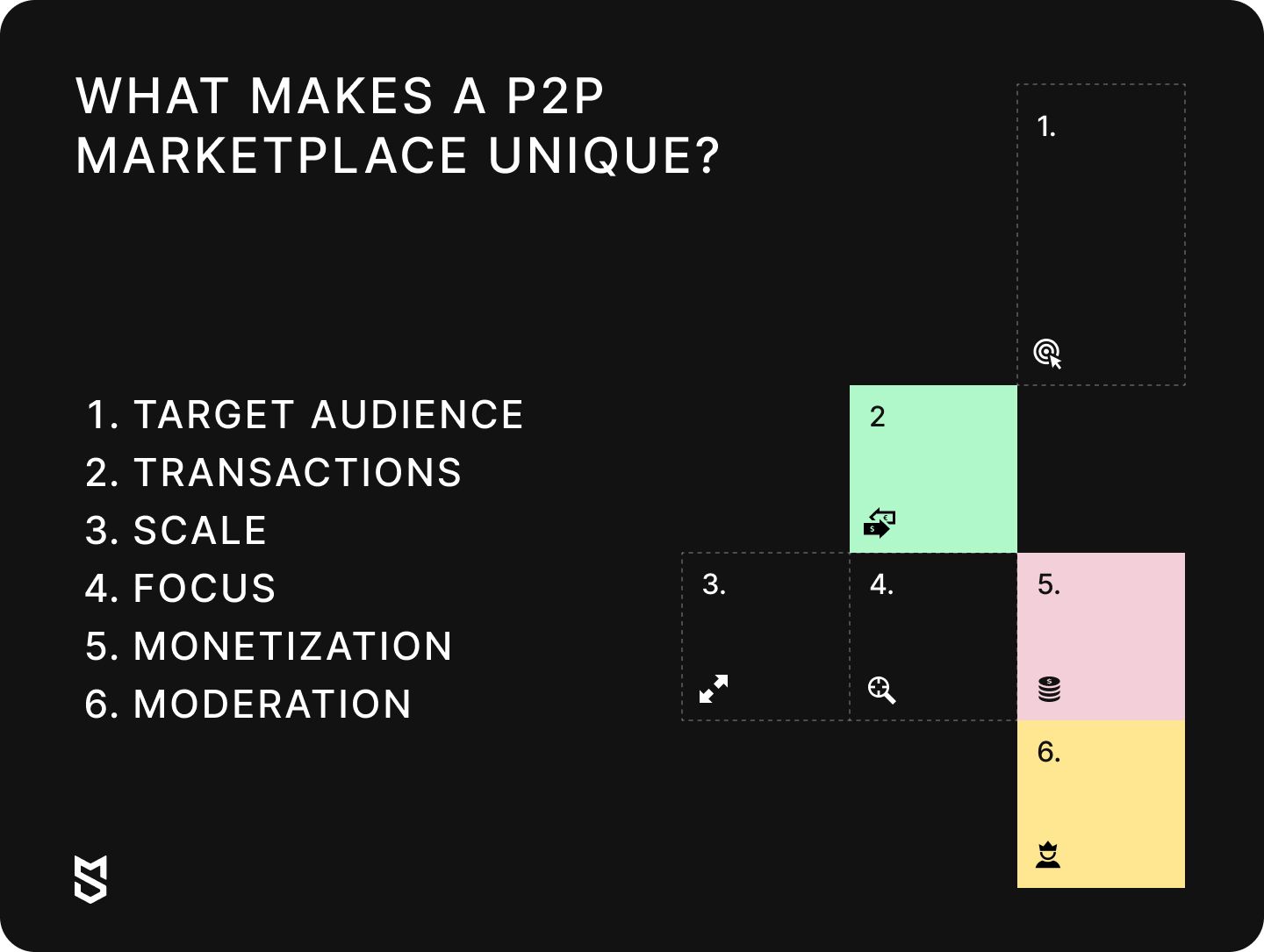
If we take only a cursory look, a peer-to-peer marketplace seems the same as a classifieds platform. Both offer space for sellers and buyers to find each other and do business. However, the two are quite different if we look just a little deeper. Here, let us show you a short comparison between the two.
Target audience of P2P marketplaces
First and foremost, classified websites are basically platforms for sellers to place ads just like they did before the internet when people placed ads for products and services in newspapers.
- Classified newspapers and websites offer space for sellers. Buyers find what they need and contact the seller by phone, messenger, email, or a built-in chat.
- A buyer doesn’t necessarily need to even be registered on a classified website to buy products or services advertised on it.
- Classifieds traditionally offer singular postings. Sellers post separate ads for things they sell, and when the deed is done they might not sell anything else, or they might sell something completely unrelated to prior listings.
Peer-to-peer marketplaces, on the other hand, differ in major ways:
- P2P platforms offer a platform for both sellers and buyers.
- Users can play both roles: a seller can become a buyer and a buyer can sell something. The two roles are equal and easy to switch between. Hence, the name peer-to-peer.
- P2P sites usually host sellers who offer a certain type of product or service regularly. Basically, each seller on a P2P marketplace is an existing shop instead of a one-time exchange.
- Many P2P marketplaces have functionality to follow sellers to know when they restock or add new products.
Dealing with transactions
With classified websites, transactions typically take place off the platform via a channel mutually agreed by the seller and buyer.
On P2P marketplaces, you see a product you want, you pay for it right then and there, and you have it delivered to you.
P2P marketplaces offer tools to facilitate the buying process, including a means to pay for products and services.
Marketplace owners should carefully select a payment gateway, as they'll be responsible for the money buyers pay to sellers.
Scale of business
Most classified websites deal locally. Even giants like Craigslist operate by locales instead of offering a single global catalog of listings. This is because, as a rule, classified websites aren’t equipped to deal with payments and delivery. Buyers and sellers can meet to exchange a product for cash, or they can use a local delivery service and money transfer options.
P2P marketplaces can deal globally. With payment functionality included, anyone from anywhere can buy a product and have it delivered to their doorstep. However, if you want to start a P2P marketplace that operates globally, you need to take into consideration more things than for a local P2P marketplace.
Focus
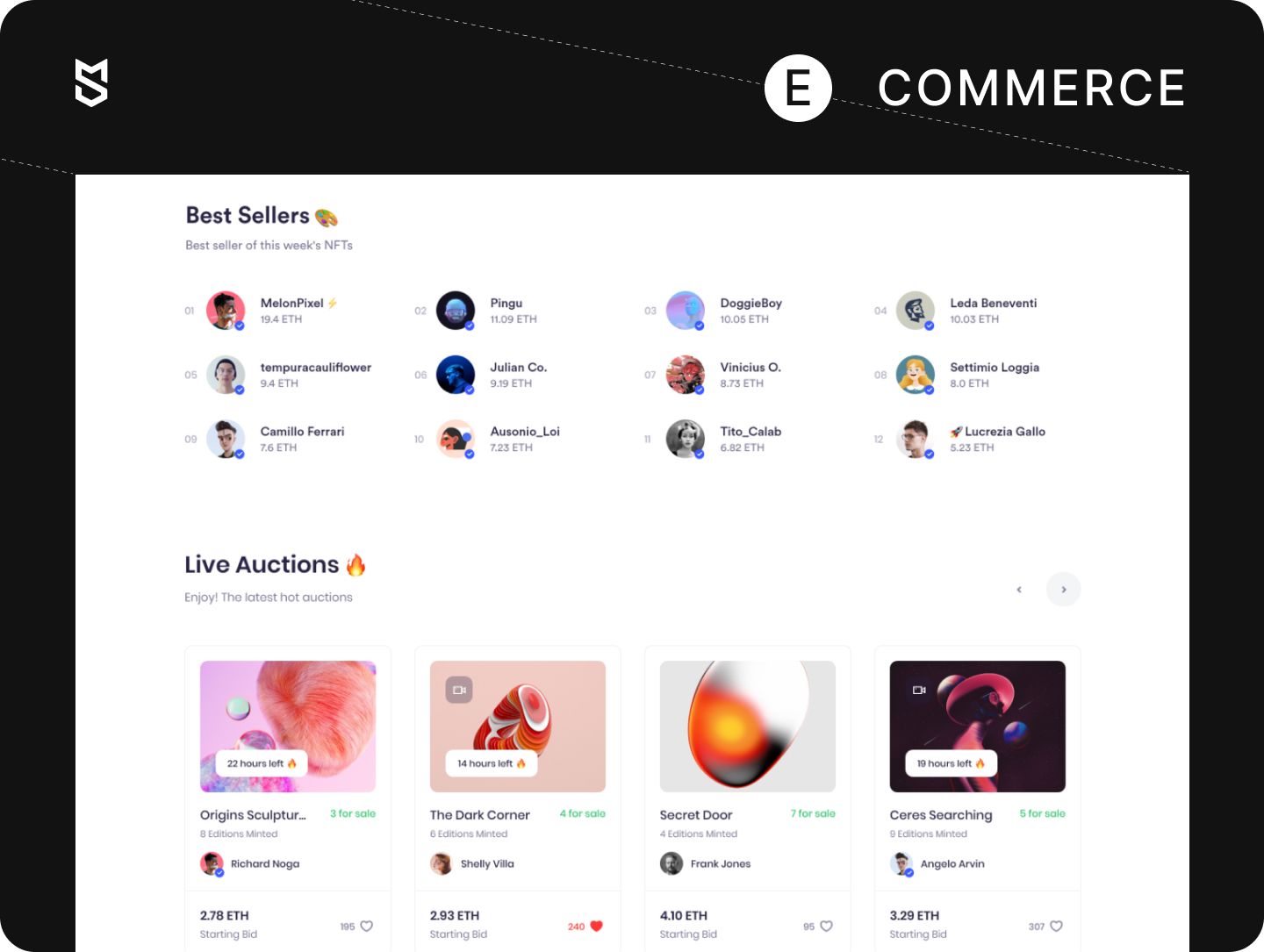
There are a number of world-famous peer-to-peer marketplace platforms that aren’t limited to a single niche. Amazon, AliExpress, and eBay easily come to mind. However, we’d say it’s not very sensible to try taking down mammoths. One of the perks of global eCommerce is that you can always expand later.
It’s way easier to find success in a niche. If you need examples of peer-to-peer marketplaces that became highly successful in a niche, there are quite a few:
- Etsy — a marketplace for hand-crafted goods
- Airbnb — a rental marketplace that connects travelers with people who share accommodation for short periods of time
- Uber — a famous on-demand taxi service that’s also a P2P marketplace
- Upwork — a marketplace that connects freelancers with clients
The list goes on. When you create a peer-to-peer website from scratch, you should first have a focus. Once it finds demand, you can expand into bordering markets, then offer more and more until you’re the new eBay. If you want to, that is. Or you can stay an Etsy. The company did have over 110% growth and over $1.726 billion in revenue in 2020.
Monetization
A P2P business model is similar to that of a classifieds’ platform — it’s decentralized and allows sellers and buyers to connect directly one way or another. As for making money from the platform itself, P2P and classifieds are also quite alike. Just as classified websites do, marketplaces usually charge sellers, not buyers.
Most classified websites offer premium listings as their business model; others use ads (some combine the two). It’s also possible to use a pay-per-click model or implement limits for free accounts. All these monetization methods are used in P2P marketplaces. But usually, marketplaces charge fees:
- For listings
- For sales
- For currency conversions
Depending on the niche, there might be other fees.
User moderation
Finally, one of the biggest and most significant differences between a classified website and a peer-to-peer website lies in the responsibility carried by the platform owner. That’s not to say classified websites are unreliable, of course. There are ways to ensure that a site offers quality services.
But with P2P, the reliability is on a whole other level.
If you plan to create a P2P marketplace platform, you’ll need to implement more control over site users and content. You’ll also need different features from those classified websites provide.
How to make a peer-to-peer marketplace website
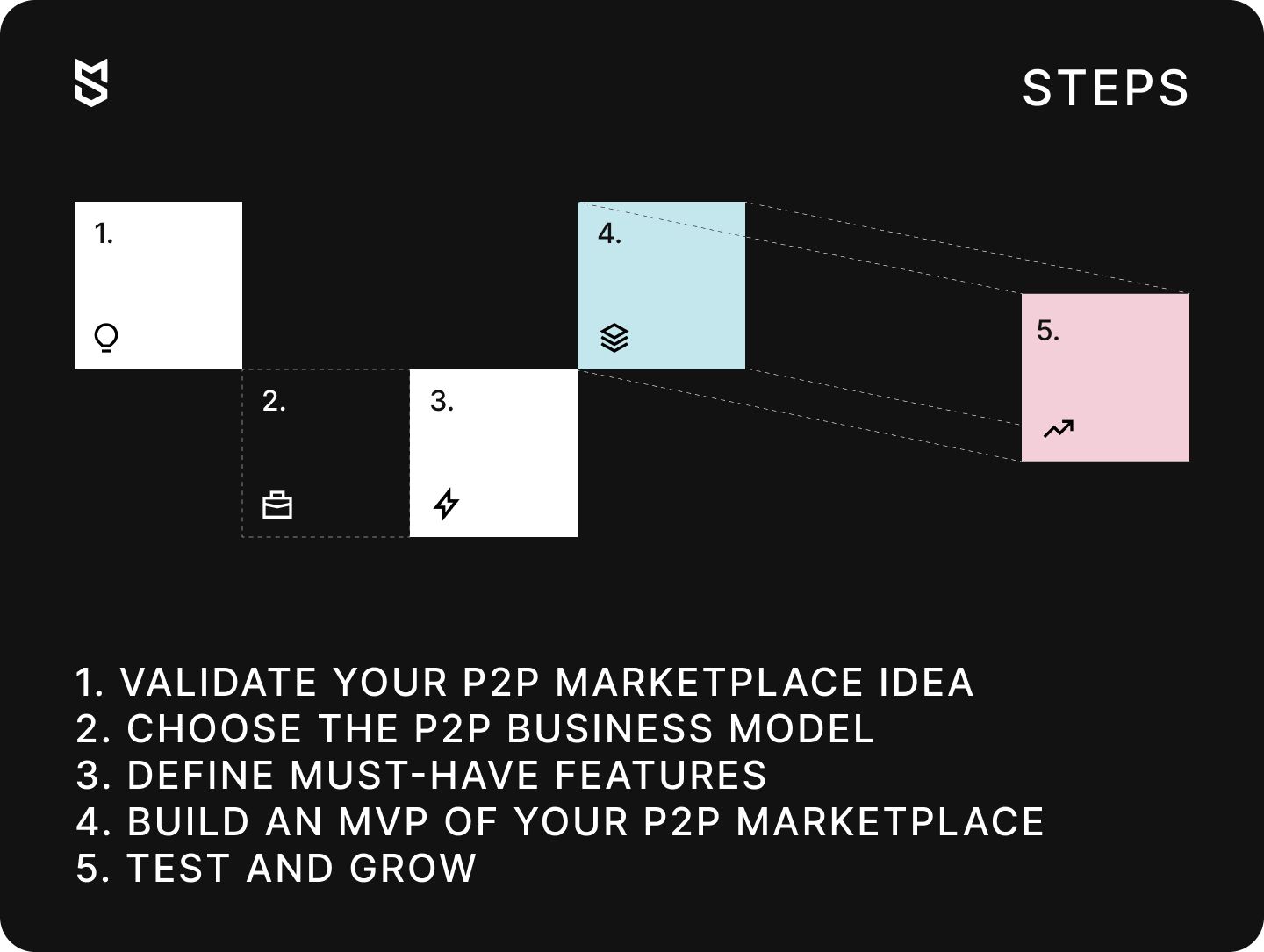
Most business owners who plan to create a two-sided marketplace start with building a website. Building an online marketplace on the web is faster and cheaper than building a mobile app, and these two factors play heavily into success in an overcrowded global market.
At the same time, having an app in addition to a website is a big perk in the eyes of users — when it comes to convenience, even a well-adapted mobile website isn’t the same as an app.
In building a peer-to-peer marketplace app, you have two options:
- Build a single p2p app for both sellers and buyers, with the ability to switch roles or with all functionality available to all users. Example: OLX
- Build separate apps for buyers and sellers. Examples: Etsy, Uber, and most marketplace apps
The reason most P2P marketplace platform owners prefer separate apps is that:
- for sellers, a website is often the ultimate platform while buyers find mobile apps more convenient
- with buying and selling functionality joined in a single app, the app can become cumbersome and heavy
- it’s not like every buyer wants to be a seller, after all
If you’re not sure which type of app will fit you best, your project manager can help. One of the important roles of a project manager in an outsourcing development company is to help you with issues like this.
Now let us give a brief view of the steps to make a peer-to-peer marketplace website or app.
#1. Validate your P2P marketplace idea
For a venture to be successful, it needs to find its product-market fit. For this, project managers conduct the idea validation process. Basically, idea validation is the process of proving that your investment into the product will be worth it. This process includes finding your target audience, unique value proposition, assessing your business strengths, weaknesses, opportunities, and threats.
#2. Choose the P2P business model
A peer-to-peer marketplace is a decentralized model that acts as an intermediary between sellers and buyers (or service providers and consumers). Being decentralized, P2P platforms have a selection of ways to earn revenue:
- Transaction fees (flat or in % of transaction amount)
- Flat fees for service access
- Ads (for number of ad shown or as pay-per-click)
With proper research, you and the team you hire will be able to find the best model (or models) for high profitability.
#3. Define must-have features
As software development can be a lengthy and expensive process, it’s sensible to assess the importance of each feature you plan to implement before you build an ecommerce P2P marketplace platform. Some of them will be must-have features and others will be optional — you can postpone their implementation.
#4. Build an MVP of your P2P marketplace
An MVP is an abridged version of a platform created with several purposes:
- early launch
- testing your peer-to-peer marketplace idea validity and profitability
- marketing and building brand recognition
- possible early adopters and revenue
The eCommerce market has an abundance of players, therefore, early launch will play in your favor.
#5. Test and grow
With the MVP launched, you’ll need to carefully analyze its performance and make adjustments for full launch and future updates so that your business can grow and be successful. This is the time to test hypotheses and attempt certain risks. We do advise allocating ample time and resources for testing and monitoring as data-driven decisions are the best ones to build a business upon.
Peer-to-peer marketplace platform features list
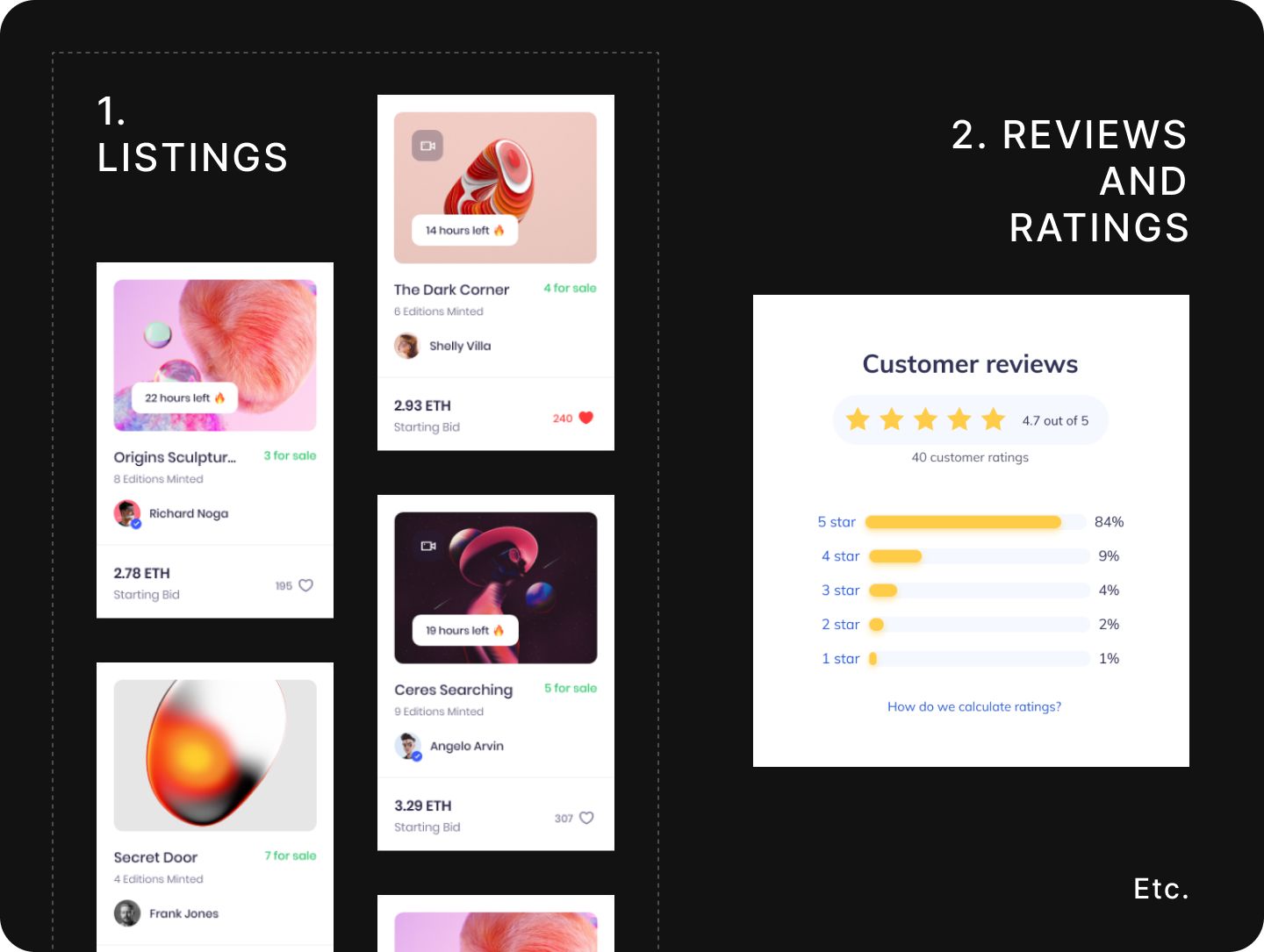
There are features every P2P marketplace platform needs. We’ll cover those here. Other features you’ll need to implement in your peer-to-peer marketplace software will depend on the niche you choose. You’ll know best what those additional features are.
The following features should be implemented in your peer-to-peer website as well as in any app.
Sign up/Sign in
An option to sign in with a Google or Facebook account is practically a must nowadays — it’s faster for users and it links a social network account to the marketplace account.
Additionally, we recommend implementing some kind of verification, especially for sellers. This is even more important if you’re planning to build your own online marketplace website that offers services, not products. For example, Uber requires drivers to submit a list of documents verifying their identity and driving experience.
Profile
A profile page displays a user’s name, an icon or photo, the number of orders completed, the average rating, and contact information. An Etsy seller profile page also displays items sold. Since P2P marketplaces are to be heavily monitored and the owner needs to be notified if someone (a seller or buyer) is committing fraud, it’s not unusual to see a report button on user profiles.
Listings
The screen with product listings will look different for sellers and buyers.
Sellers should see their own items and options to add or remove them, edit descriptions, change prices, and publish or unpublish items. It’s reasonable to implement a search feature and filters/categories within the store for sellers as well as for buyers.
Buyers should see product images and short description on the main page and in search results, and full description as well as more pictures on the product page. Some marketplaces provide a button to add an item to the cart or follow an unavailable item right from the general listings page without going to the product page.
Search and filters
Search and filters are vital for any website or app that sells different products. Even within a small niche, you still have variations. The same product can be offered in a variety of colors or sold by multiple sellers for different prices. The same goes for services — they can be provided by a number of sellers in different areas, for example.
It should be possible to search for a specific product and/or filter listings. If you’ve got a somewhat big range of products or services offered on your marketplace, consider adding categories too.
Cross-selling
When developing a peer-to-peer marketplace, make sure that the website has an up-selling and a cross-selling features. Implementing features like Recommended or With this item, people also buy might help sellers sell more, which will increase your revenue as the platform owner as well.
Bookings and schedules
If you plan to start a peer-to-peer online marketplace that offers services instead of items — for example, an Airbnb-like rental service, you’ll need to implement a system to book the service. You’ll need a calendar for sellers and buyers to know when the service will be available.
Payment functionality
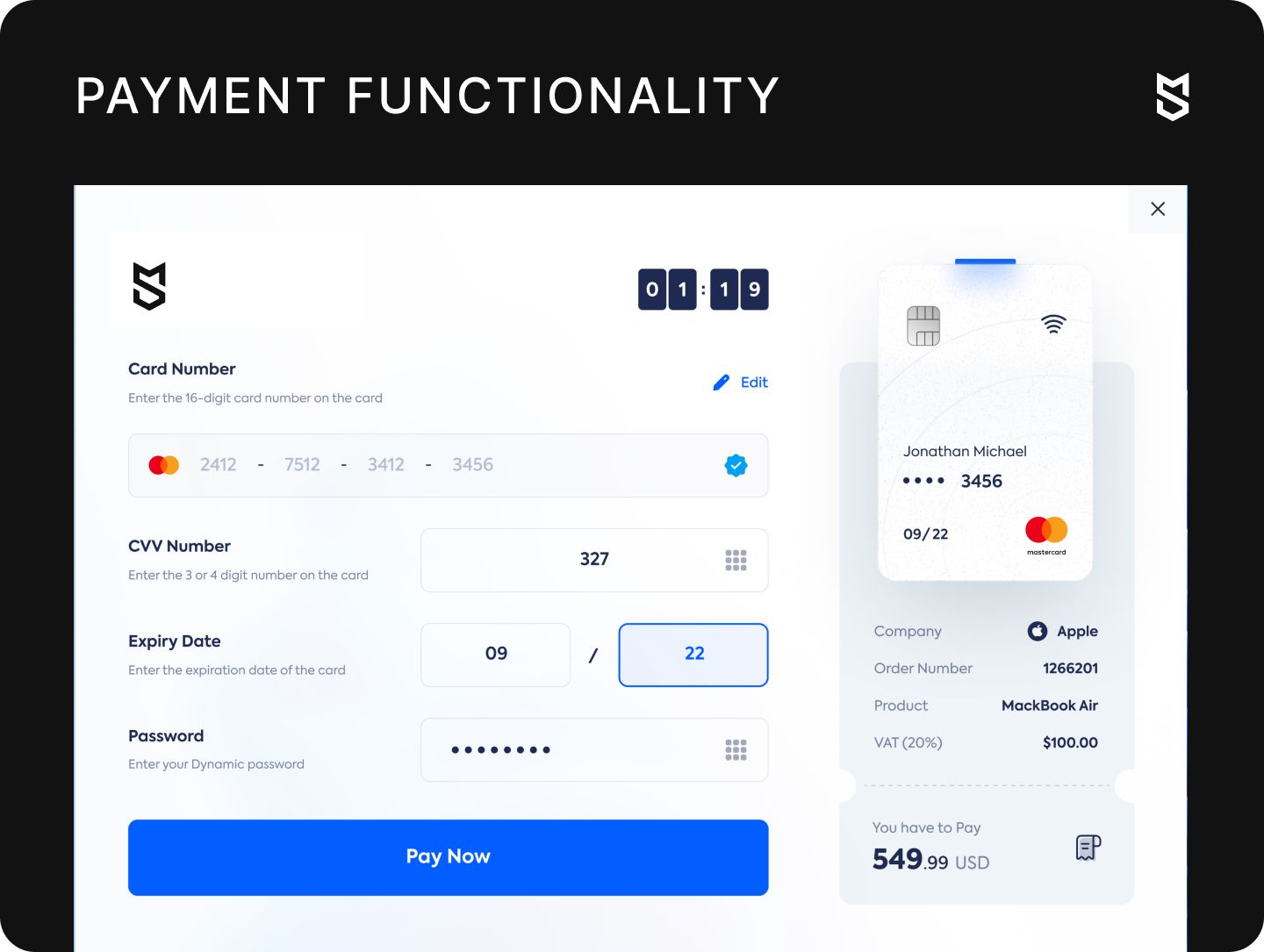
Payment functionality is one of the major differences between a P2P marketplace and a classified website. You’ll need to integrate a payment gateway that’s secure and reliable: you’re dealing with people’s money and credit card details, after all.
It’s also important for marketplaces that money transfers are dealt with swiftly so sellers can ship orders as soon as possible.
Reviews and ratings
In the Uber app, riders can rate drivers and drivers can rate their passengers. It’s a good practice to implement ratings — it will help users on both sides of your platform decide whom to work with. It will also help you monitor both sellers and buyers, weed out untrustworthy ones, and resolve disputes.
Reviews make ratings look more reasonable and add credibility. You can also restrict rating and reviewing features to users who have completed an order/made a purchase.
Notifications
Notifications are important for timely order completion. Sellers must know when they have orders, and buyers want to know when items they’re tracking are available, when the price has dropped, and when the shipment status of their order has changed. Notifications must also be implemented for direct messages and other methods of communication.
Communication functionality
A good multivendor marketplace requires a way for buyers and sellers to communicate. Built-in messaging allows buyers and sellers to avoid disputes. When an order isn’t shipped in a timely manner, a buyer can contact the seller for information instead of opening a dispute right away, for example.
If your P2P website works in a niche where product customization is possible (hand-made products or basically any services), direct messaging or chat will help the two sides decide on details.
Tracking
Order tracking is actually a fairly rare feature on smaller P2P marketplaces. However, this is what makes it so good: You can offer it as a unique value your global eCommerce platform provides.
Overseas shipping can sometimes take weeks. This feature, implemented on both the seller and buyer sides of your platform, will help your users feel at ease knowing where in the world their items are. Tracking can also come in handy in resolving disputes.
Dispute resolution
Something always goes awry, especially at the very beginning of any business. In addition to a button to report a user (mentioned above), users — both buyers and sellers — need an option to open a dispute. This is important when the product the buyer receives is of poor quality or damaged, or when a seller/service provider suffers some kind of loss — health-related, material, or financial — due to a deal. Disputes must be resolved by the platform owner in accordance with the platform’s Terms and Conditions and Privacy Policy.
Wish list
This can be a list of favorite items, a list of favorite service providers, or the ability to follow stores. Wish lists help buyers remember items they want to purchase later or order again. You can also implement functionality to share wish lists; in this case, users can notify their friends and family of products they’d like to have but can’t/won’t buy themselves. You know, like a traditional wishlist.
History of purchases
This feature helps buyers keep track of what they’ve purchased and when. It’s important for tracking orders, resolving disputes, and — let’s be honest here — managing personal finances :)
Statistics
Two types of statistics exist for P2P marketplaces. Statistics for sellers might be a great value offer as this feature can facilitate their analytics and see which products sell better. For you as the platform owner, statistics might also provide insights into your platform’s usability.
Admin panel
Admin panel isn’t really a feature, it’s a side of your platform where only you or your designated employees have access. The admin panel is used to:
- monitor and moderate content (remove fraudulent accounts and inappropriate content)
- create events and other buyer and seller perks
- implement discount systems (with promo codes or other limitations)
- monitor platform performance
Admin panel is traditionally built for web or tablet and has very basic UI design.
P2P marketplace design best practices
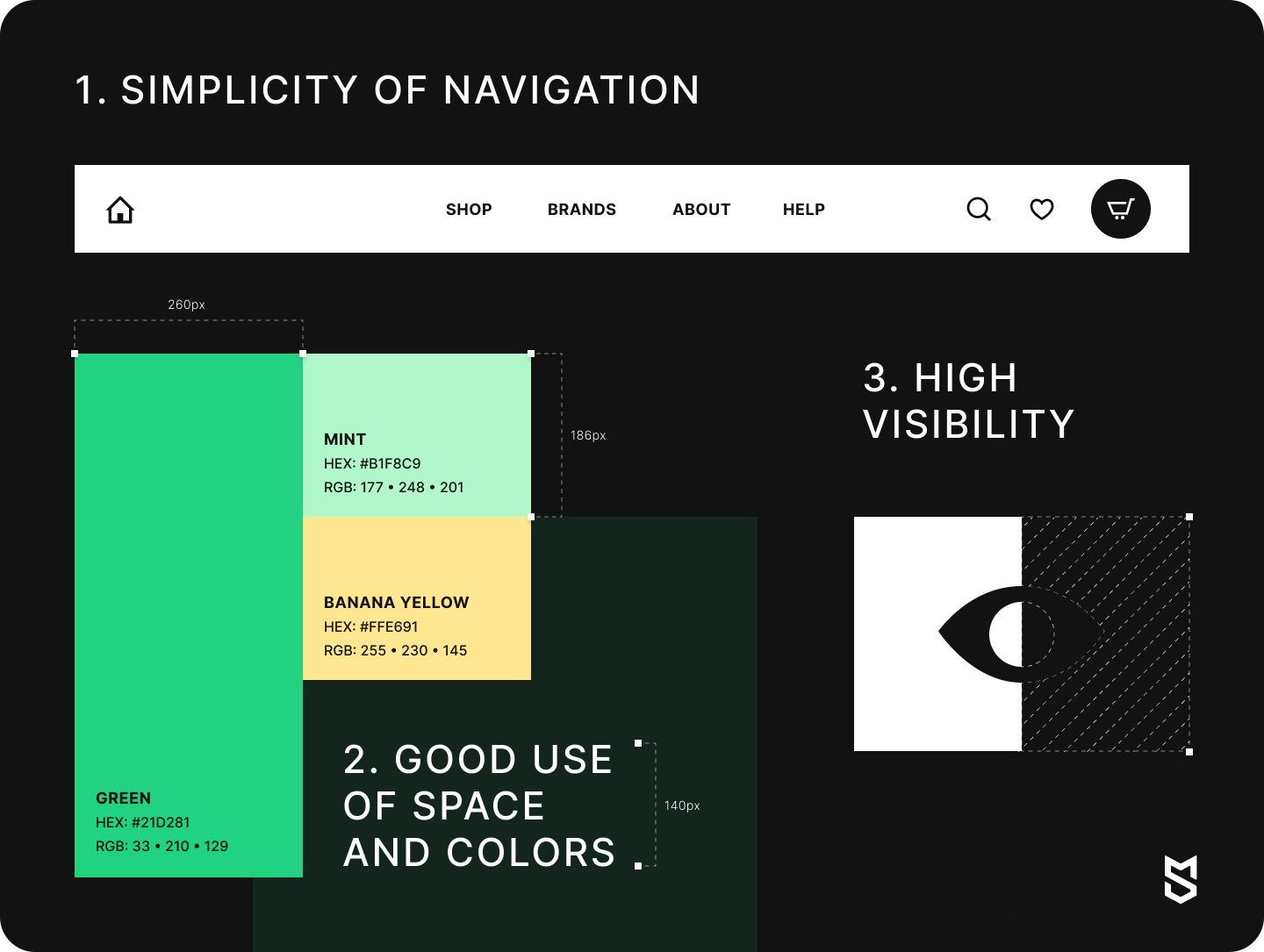
When you build an ecommerce P2P marketplace platform, its UI/UX design is one of the parts you need to pay a lot of attention to. Some would even say that well-thought-out design is the most important thing for a marketplace. Even with the most advanced features, poor design decisions can make the platform unusable; and with multiple alternatives on the market, this can turn into a disaster.
So what best practices exist today for P2P marketplaces? Here are just the major ones.
Simple navigation
The more features you add to your platform, the simpler and more straightforward you need to make the user journey. That’s because if your users get lost in the sea of options they’ll most likely abandon the platform altogether. Nobody likes a cluttered hard-to-navigate website or app.
It’s best to have core features visible from the main page, and features used only occasionally hidden behind an easy-to-access menu.
Balanced use of space and color
Minimalist trends and ample use of white space in UI/UX design are very prominent in online marketplaces and it’s easy to see why: on a marketplace, the end user must be easily hooked to the image of the items sold.
It’s ill-advised that the interface is made visually cluttered or over colored to the point of distraction. A good practice for P2P marketplaces is a clean interface with limited accents that will turn the attention to important places, like catalogs of items or services sold.
Visible action buttons and icons
As a continuation of the previous advice, this is where your color accents should probably go:
- Buttons (view item, add to wish list, add to cart, item images, etc.)
- Logos and icons of sellers so that users know who they’re buying from
- Your brand elements (logo, corporate colors) so that users easily remember your platform
- Payment options — provide logos of payment systems your platform uses instead of just their names
- Anything you need to attract attention to — specific features or menus, event announcements, and so on
By accenting only what’s important you’ll create a seamless and pleasant experience for users, which will make them come back to your P2P marketplace platform.
P2P marketplace tech stack
The full stack of technology to build a P2P marketplace can vary depending on specific features you decide to implement and the team you work with. Some things you will need to consider are below.
- Reliable servers for the platform to be online 24/7. Cloud servers are often recommended for marketplaces since they’re more secure, stable, and offer backups.
- Ample storage space to host quality images since buyers on P2P marketplaces buy products based on visuals — photos and videos — only. A good option would be Amazon S3.
- Data storage facilities with high security for, well, hosting databases. We recommend Amazon RDS.
- CDN — a network for content distribution so that all users get reliable and fast-performing platform regardless of geographical location.
What is the cost to create a peer-to-peer marketplace?
Now let's figure out the cost to develop a peer-to-peer marketplace.
To build a P2P marketplace website, you’ll need a development team consisting of the following specialists:
- Project manager
- UI/UX web designer
- Frontend developer
- Backend developer
- QA specialist
Usually, you won’t require more than one of each specialist to build a marketplace website unless you need everything done as fast as possible.
Developing a P2P website MVP with a team of five will take about 5 months; the cost of work like this will start at $60,000 and will increase as you add more features or more people to get the website done sooner.
On the other hand, if you decide to switch the traditional order and build a mobile application first, here’s a list of the people you’ll have to hire:
- Project manager
- UI/UX designer specializing in mobile apps
- Android developer
- iOS developer
- Backend developer
- QA specialist
You’ll need one of each specialist on the list, the same as with website development. If you decide to make an app for only one platform, you’ll need either an Android or iOS developer, not both. Mobile app development can take a bit longer than website development, so think about 5 to 6 months.
To design a custom mobile P2P marketplace app for both platforms can cost anywhere from $83,000 and up.
At the same time, if you’re wondering how to build a peer-to-peer marketplace website AND two native mobile apps, don’t simply sum the amounts above. The backend — the server part — is the same for web and mobile apps. Similarly, one QA specialist can test all three apps and the server part as well, though they’ll need more time to do that. You’ll still need separate UI/UX designers, in most cases (or more time), as designing a web interface is completely different from designing a mobile one.
Mind Studios’ managers can offer more precise estimates for both time and investment necessary to develop a P2P website as well as one or two native mobile apps.
What about P2P marketplace builders?
The closest similar solution to a custom P2P marketplaces development is using SaaS solutions, i.e. website builders.
Website builders offer you an opportunity to launch a peer-to-peer marketplace really fast and quite cheap. However, one needs to approach this option with careful consideration as P2P marketplace builders have their drawbacks as well.
We can point out several of such drawbacks:
- Limited customization. However sophisticated a SaaS platform is, its customization will always be limited by its initial code. This means the most unique thing about a P2P marketplace built with a website builder will most likely be its branding: colors, logos, communication style.
- Limited feature set. Same as with customization, the features you get for your marketplace are only those the builder has, you can’t add more since you don’t have access to the code. This also pertains to the integration of third-party tools like analytics. And not all builders offer advanced features like tracking, for example, or even multiple payment options.
- Security issues. While it’s possible for a website builder to have top-shelf security, it’s not a given. Finding a quality builder with good data security might take quite some time. You can choose not to store users’ financial information on your P2P marketplace to somewhat mitigate risks, but they’ll still need to input this data when the purchase is made. If you decide to use a builder, pay close attention to its security.
Overall, P2P marketplace builders are useful for startups with limited resources and tight schedules, as well as those that have little or no competition in their chosen niche. When competition on the market becomes heavier, your platform will need to stand out, and for this, custom development is generally more suitable.
Challenges of peer-to-peer marketplaces
Peer-to-peer marketplace ideas are popular among startup owners and seasoned business people alike. This is mainly because they offer high possible revenue without costs and struggles of production and shipping. However, it’s not a challenge-free endeavor.
A big issue with P2P marketplaces is the trust of users. This is especially true for platforms like Uber or Airbnb where comfort and safety of buyers are at stake. Ensuring that your platform hosts honest sellers is a must to earn a good reputation.
Depending on the niche your marketplace operates in, you’ll have different tools to monitor reputation and establish trust. The system of ratings and reviews is a viable option on most marketplaces. On marketplaces that provide services, you can set up check-up processes before allowing a seller on your platform (this is what Uber does for their drivers, by the way).
P2P Marketplace Development: Conclusion
There are certainly difficult parts to P2P marketplaces development, like dealing with payments and maintaining your users’ privacy. You’ll also need to resolve disputes that arise — hopefully, not too often. Marketplaces need constant monitoring if you want to preserve your reputation and gain a following.
But all that comes after development is complete and your platform is launched. To develop your app, you can work with an outsourcing company. Mind Studios is one of such companies. We offer full-cycle development as well as maintenance for P2P marketplaces.
Get in touch with us for a cost estimate and a free consultation about how to build a peer-to-peer (P2P) marketplace.


